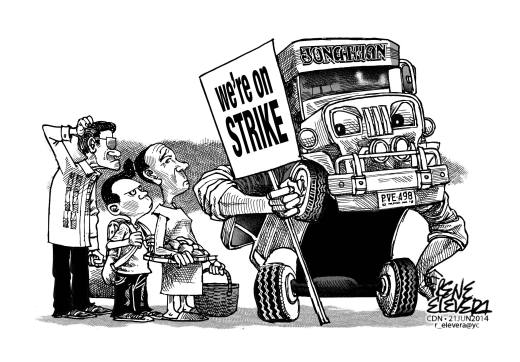Very few local officials in Cebu, in fact, only a few residents expected last Thursday’s transport strike, caravan, pahulay (rest) or whatever the transport groups called it, to result in scores of stranded commuters in Metro Cebu.
The estimates of local transport groups and officials place the number of affected commuters at 10 to 30 percent depending on whom one asks. Suffice it to say that hundreds of commuters were left waiting to hitch a ride from a friend’s car or flag down taxis who along with the private car owners had most of the roads to themselves.
Mandaue City was hit hard by the transport strike, which eased up somewhat in the afternoon. Yet when the strike ended, the passengers could hardly wait to scramble for seats in the passenger jeepneys especially public school students whose classes were suspended.
A few observations: While the Cebu City government prepared for the transport strike by fielding Kaohsiung buses, this didn’t sit well with the protesting public utility vehicle drivers who harassed the bus drivers and any PUV drivers who thought better than joining the strike and instead resumed their livelihood.
Early reports showed that no taxis sustained flat tires due to spikes placed on the road by protestors but they were only trying to avoid a public backlash.
Aside from the fare increase, the local transport groups are objecting to a joint administrative order of the Department of Transportation and Communications (DOTC) imposing stricter penalties on colorum vehicles and drivers engaged in overcharging, discourteous behavior and using defective taxi meters among others.
As an addendum, they also registered their protest against the looming Bus Rapid Transit (BRT) which they claim would rob them of their livelihood once it gets fully implemented in 2017.
While the BRT is another separate topic, we simply cannot swallow hook, line and sinker the argument of the transport groups that the order will be abused by traffic enforcers and by extension transport agencies to bleed them dry.
Colorum vehicles, for one, have no place plying Metro Cebu’s streets because they are antiquated and defective in the first place. And should the riding public be made to suffer the rude and abusive behavior of some drivers who not only overcharge but prey on passengers, especially females, desperate for a ride to work or home?
Indeed, have the local transport groups managed to police their own ranks? Do operators pay their drivers enough or spend enough to improve their vehicles?
At the same time, did government install mechanisms in place to prevent the transport agencies from exploiting the order for their own ends? The DOTC should bear this mind as they enforce the order with the end goal of protecting the riding public’s interest.
